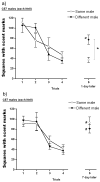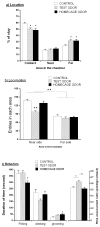Scent marking behavior as an odorant communication in mice
- PMID: 18565582
- PMCID: PMC2577770
- DOI: 10.1016/j.neubiorev.2008.05.012
Scent marking behavior as an odorant communication in mice
Abstract
In rodents, where chemical signals play a particularly important role in determining intraspecies interactions including social dominance and intersexual relationships, various studies have shown that behavior is sensitive to conspecific odor cues. Mice use urinary scent marks for communication with individual conspecifics in many social contexts. Urinary scent involves genetic information about individuals such as species, sex, and individual identity as well as metabolic information such as social dominance, and reproductive and health status, which are mediated by chemical proteins in scent marks including the major histocompatibility complex and the major urinary proteins. The odor of the predator which can be considered to be a threatening signal for the prey also modulate mouse behavior in which scent marking is suppressed in response to the cat odor exposure in mice. These odorant chemicals are detected and recognized through two olfactory bulbs, the role of which in detection of chemosignals with biological relevant appears to be differential, but partly overlapped. Mice deposit scent marks toward conspecifics to maintain their social relationships, and inhibit scent marking in a context where natural predator, cat odor is contained. This suppression of scent marking is long-lasting (for at least 7 days) and context-dependent, while the odorant signaling to conspecifics tends to appear frequently (over 24h but less than 7 days intervals) depending on the familiarity of each signal-recipient. It has been discussed that scent marking is a communicative behavior associated with territoriality toward conspecifics, indicating that the social signaling within species are sensitive to predator odor cues in terms of vulnerability to predation risk.
Figures




Similar articles
-
Social features of scent-donor mice modulate scent marking of C57BL/6J recipient males.Behav Brain Res. 2009 Dec 14;205(1):138-45. doi: 10.1016/j.bbr.2009.07.007. Epub 2009 Jul 16. Behav Brain Res. 2009. PMID: 19616031 Free PMC article.
-
Scent marking behavior in male C57BL/6J mice: sexual and developmental determination.Behav Brain Res. 2007 Aug 22;182(1):73-9. doi: 10.1016/j.bbr.2007.05.007. Epub 2007 May 22. Behav Brain Res. 2007. PMID: 17561279 Free PMC article.
-
Central oxytocin regulates social familiarity and scent marking behavior that involves amicable odor signals between male mice.Physiol Behav. 2015 Jul 1;146:36-46. doi: 10.1016/j.physbeh.2015.04.016. Physiol Behav. 2015. PMID: 26066721
-
Scent marking strategies of New World primates.Am J Primatol. 2006 Jun;68(6):650-61. doi: 10.1002/ajp.20258. Am J Primatol. 2006. PMID: 16715511 Review.
-
Influence of Cat Odor on Reproductive Behavior and Physiology in the House Mouse: (Mus Musculus).In: Mucignat-Caretta C, editor. Neurobiology of Chemical Communication. Boca Raton (FL): CRC Press/Taylor & Francis; 2014. Chapter 14. In: Mucignat-Caretta C, editor. Neurobiology of Chemical Communication. Boca Raton (FL): CRC Press/Taylor & Francis; 2014. Chapter 14. PMID: 24830030 Free Books & Documents. Review.
Cited by
-
What it takes to be at the top: The interrelationship between chronic social stress and social dominance.Brain Behav. 2020 Dec;10(12):e01896. doi: 10.1002/brb3.1896. Epub 2020 Oct 17. Brain Behav. 2020. PMID: 33070476 Free PMC article.
-
From Multisensory Assessment to Functional Interpretation of Social Behavioral Phenotype in Transgenic Mouse Models for Autism Spectrum Disorders.Front Psychiatry. 2020 Nov 19;11:592408. doi: 10.3389/fpsyt.2020.592408. eCollection 2020. Front Psychiatry. 2020. PMID: 33329141 Free PMC article. Review.
-
Oxytocin receptor and Mecp2 308/Y knockout mice exhibit altered expression of autism-related social behaviors.Physiol Behav. 2012 Dec 5;107(5):641-8. doi: 10.1016/j.physbeh.2012.02.024. Epub 2012 Mar 3. Physiol Behav. 2012. PMID: 22406388 Free PMC article. Review.
-
TMEM16B Calcium-Activated Chloride Channels Regulate Action Potential Firing in Lateral Septum and Aggression in Male Mice.J Neurosci. 2019 Sep 4;39(36):7102-7117. doi: 10.1523/JNEUROSCI.3137-18.2019. Epub 2019 Jul 18. J Neurosci. 2019. PMID: 31320449 Free PMC article.
-
The Effect of Gentle Handling on Depressive-Like Behavior in Adult Male Mice: Considerations for Human and Rodent Interactions in the Laboratory.Behav Neurol. 2018 Mar 6;2018:2976014. doi: 10.1155/2018/2976014. eCollection 2018. Behav Neurol. 2018. PMID: 29692869 Free PMC article.
References
-
- Adamec R, Head D, Blundell J, Burton P, Berton O. Lasting anxiogenic effects of feline predator stress in mice: sex differences in vulnerability to stress and predicting severity of anxiogenic response from the stress experience. Physiol Behav. 2006;88:12–29. - PubMed
-
- Anderson PK, Hill JL. Mus musculus: Experimental induction of territory formation. Science. 1965;148:1753–1755. - PubMed
-
- Apfelbach R, Blanchard CD, Blanchard RJ, Hayes RA, McGregor IS. The effects of predator odors in mammalian prey species: a review of field and laboratory studies. Neurosci Biobehav Rev. 2005;29:1123–1144. - PubMed
Publication types
MeSH terms
Substances
Grants and funding
LinkOut - more resources
Full Text Sources
Miscellaneous

